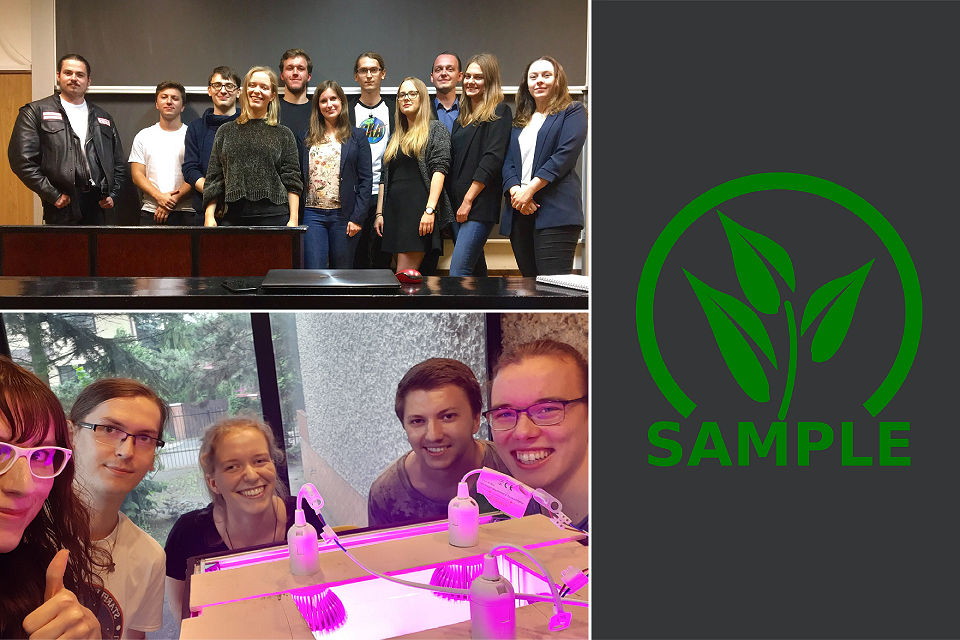The film buffs among us are probably familiar with “The Martian” by Ridley Scott and the image of Matt Damon, a survivor on the Red Planet, as he is trying to grow potatoes under those rather unconventional conditions. From a scientific point of view, his efforts as depicted in the movie made very little sense; however, they inspired the audience to reflect on the possibility of growing edible plants in conditions other than on the Earth. This was the dilemma faced by our students taking part in the international IGLUNA 2020 Project.


The student team comprises young researchers from the Student Astronaut Club (at the Faculty of Power and Aeronautical Engineering) and the Herbion Biotechnology Scientific Club (at the Faculty of Chemistry) which are supervised by Jan Kindracki, Ph.D., Eng., Professor at the Warsaw University of Technology. They are among 15 teams that take part in a challenge devised by the Swiss Space Center in collaboration with the European Space Agency. The purpose of the exercise is to develop a technology for space exploration and for creating a human habitat in an extreme environment, such as the Moon.
A garden on the Moon
Our students decided to design a system to sustain plants in space. However, a number of other teams decided to pursue similar projects, therefore the representatives of the Student Astronaut Club and of Herbion wanted to make something different that will help them stand out from the crowd.
“What we had in mind were small habitats where astronauts are spending their time – every cubic meter there is extremely valuable, both literally and figuratively. First of all, the cost of building anything outside the Earth is gigantic; in addition, such a habitat is relatively small; if we added a module for growing plants, it would significantly affect the comfort of staying in such a place. Hence, the idea to create a separate area outside the habitat that would become an actual garden sheltered from extreme conditions.The conditions inside that area would be adapted to suit the needs of the organisms kept there which are frequently less demanding than humans,“ says Joanna Majsak, deputy coordinator of the project. The project could also be used on Earth in places where the climate is not favourable to plants, which is an additional advantage.
The idea came to be known as the SAMPLE, or the Semi-Autonomous Modular Plant and other Life-sustaining Experiment, which – to use a plain language – is an experimental semi-autonomous module for storing biological samples.
One of the main assumptions was to create a modular system. Each element of the module would operate autonomously and each one could offer different conditions. The conditions in the modules would be controlled by a special software. Supervision from within the habitat would be possible but not necessary. Astronauts would receive updates on what is going on inside and they would assess, based on the data and pictures, whether the “green box” needs to be taken to the habitat so that a mature plant can be taken out.
Forced evolution of the idea
The participants of the first edition of IGLUNA project tested their concepts during a field campaign on a glacier. This year, the organisers decided to change the location and announced that the final stage of the competition would be held on Mount Pilatus in Switzerland. Due to heavy winds and rainstorms, thunderstorms and hail as well as the temperature, the new location proved to be quite a challenge – lab conditions differ much from the natural conditions that can be quite unpredictable.
The on-site field campaign was cancelled because of the pandemic and a virtual finale was scheduled.
As a consequence of all those changes, the students had to modify their idea. In the end, the main assumption of the SAMPLE team evolved and the idea was to check whether it would be possible to create a low-tech closed circulation system. The choice of nutrients for the plants, testing various tools for the production of carbon dioxide, as well as getting rid of unwelcome guests (in this case, it’s the mould) play a crucial role in that plan. The team members are testing sterilisation of coir beds, among other things. For a long time, the works were hindered because of very limited access to the university laboratory (in the wake of the coronavirus pandemic); instead, the students came up with some original ideas, such as sterilising the materials in their own… ovens.
Segregation of duties
The project activities taken by the SAMPLE team cover a number of areas. Justyna Najczuk and Paulina Walczak, two student members of Herbion Biotechnology Scientific Club, are responsible for matters related to biological aspects. Their main task is to carry out numerous tests and check the conditions for growing plants in a hermetically sealed environment. In their work, they use, among other things, yeast from the collection of Jolanta Mierzejewska, PhD. (WUT Yeast Collection). “We grow it in anaerobic conditions (without oxygen – editor’s note) in order to provide carbon dioxide which is indispensable for plant growth”, Paulina Walczak says about the yeast being tested.
The mechanical engineers, Paweł Lekan and Ryszard Zawiła, are responsible for thermal design, developing a 3D model, designing fixing, connections, and making sure the construction is airtight, among other things. Blanka Lewonowska and Mikołaj Owczarzak form a separate group. They are responsible for the software and for the electronics, for the power supply for the module and for preparing humidity, pressure and temperature sensors. They also take care of the software that photographs the plant inside the module, as well as for light control and air flow within the module. Damian Grabowski is tasked with system engineering; Justyna Wiśniewska is responsible for the project promotion, and all the activities are coordinated by Kacper Witasiński and Joanna Majsak.







































